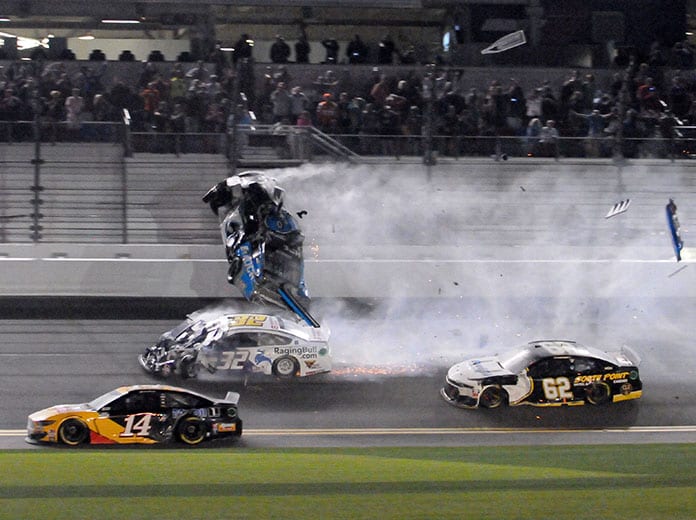
DAYTONA BEACH, Fla. — After Monday night’s horrific crash to end the 62nd running of the Daytona 500, everyone at Daytona Int’l Speedway and in the racing world took pause thinking of Ryan Newman.
To end the night knowing Newman was, at the very least, alive was something to be extremely thankful for.
Because, frankly, he probably shouldn’t be. How he survived is something beyond comprehension.
The hit that Newman absorbed coming to the finish line of The Great American Race is one that looked like it came straight out of a video game. His car was upside down, on fire, skidding in a shower of sparks.
All that alone was bad enough. Then to see Corey LaJoie’s oncoming car impact Newman’s upside-down, helpless machine just about square in the driver’s window at 200 mph was enough to make everyone’s heart stop cold.
It looked unfathomable because it was unfathomable … right up until it actually happened.
Those watching at the track stood still and cried, as did many more that I know of who were watching on television. The shock, horror and fear was only amplified when black screens went up around the accident scene as safety crews worked feverishly to extricate Newman from his stricken car.
From there, he was transported straight to Halifax Health Medical Center.
As the minutes ticked on with no word, an unnerving, almost spooky silence descended over Daytona. No one knew what to say or what to think. In that moment, there really was nothing that could be said.
It was a feeling that those who were in attendance for the 2001 Daytona 500, when Dale Earnhardt was killed in a last-lap crash, have compared to that afternoon and evening. Some of those that I communicated with back home were already prepared for the worst-case scenario.
To be truthful, I’m not sure I can blame them for thinking like that.
But Newman’s crash was vastly different than Earnhardt’s was. From the moment of that second impact between LaJoie’s car and Newman’s, it was clear how bad the situation was.
The crash was beyond vicious. Horrific and gruesome might be better adjectives. It was even worse to watch on replay, a replay this reporter wishes hadn’t had to be replayed over and over again.
It was a crash that was enough to bring even the strongest onlookers to their knees, enough to make many expect the worst.
Then, just after 10 p.m. ET Monday night, Roush Fenway Racing and NASCAR officials provided the news we all hoped to hear.
Newman was alive. He was in “serious condition,” yes, but his injuries were viewed as non-life-threatening by doctors. That in itself was a blessing compared to what could have been.
What could have been also applied to the last 500 yards of The Great American Race, as far as Newman was concerned. He was within moments of winning the Daytona 500 for the second time.
Ryan Blaney had pushed Newman to the lead on the backstretch during the final lap of overtime and Blaney was “committed to pushing him to the win” before the pair’s bumpers misaligned entering the tri-oval and Newman’s car went spinning, crashing and flying through the air.
Race winner Denny Hamlin celebrated briefly before learning of the severity of Newman’s accident, and was quick to note in the media center during the post-race winner’s press conference that “I think we take for granted sometimes how safe the cars are. But number one (thing), we’re praying for Ryan.”
Hamlin’s point is something that even made me stop and think. As the web editor for www.sprintcarandmidget.com, I deal with arguably the most dangerous short-track cars in racing.
With sprint cars and midgets, the mortality of drivers is something that side of the sport has dealt with too many times in recent years. It’s well known that those cars, often darty and with open wheels and largely open cockpits, don’t have as many of the advanced safety measures as NASCAR stock cars have.
Those safety measures are something that, when I transition back into the NASCAR garage to cover stock-car racing, maybe even I take for granted — not always thinking about the inherent danger that’s still there.
We were all starkly reminded of that danger Monday night. After Earnhardt’s death in 2001, the advent of SAFER Barriers, HANS Devices and other safety implementations all combined to help keep drivers from dying at the top level of the sport in the same way that Earnhardt, Kenny Irwin, Adam Petty and others had.
But because drivers are no longer dying or injured as frequently as they once were, doesn’t mean racing, at its core, isn’t still a dangerous sport.
As of 10:30 a.m. Tuesday morning, there were no additional specifics available regarding Newman’s condition, and there likely won’t be any updates for a bit longer until the situation stabilizes itself further. When there are updates to be passed along, that information will be provided.
However, after the latest scary superspeedway crash involving Newman — and there have been several through the years — only one thing needs to be focused on in the immediate future.
Ryan Newman is alive. And that alone should be considered a win compared to what could have been.
